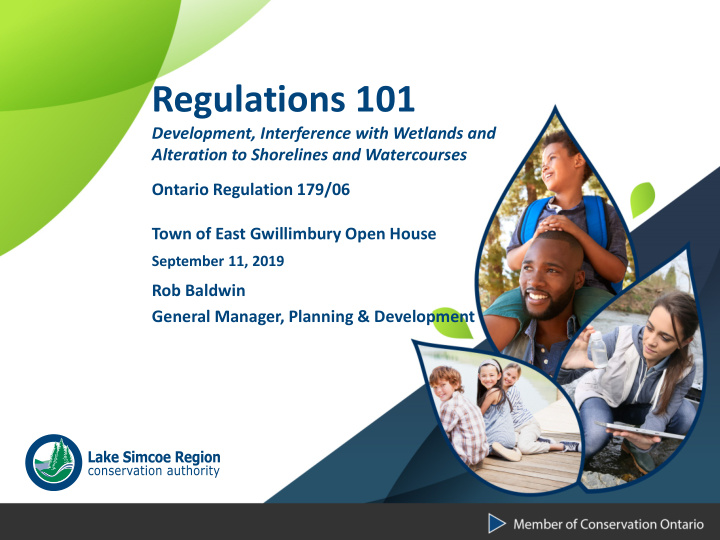



Regulations 101 Development, Interference with Wetlands and Alteration to Shorelines and Watercourses Ontario Regulation 179/06 Town of East Gwillimbury Open House September 11, 2019 Rob Baldwin General Manager, Planning & Development
Conservation Authorities’ Core Mandate Integrated watershed management is the responsibility of Conservation Authorities working in partnership with municipalities Conservation Authorities represent the Province with regard to Natural Hazards 2
Core Mandate Includes: • Flood Warning and Management • Subwatershed Planning • Implementing Provincial Legislation (i.e. LSPP, Greenbelt, Oak Ridges Moraine) • Watershed Restoration Services (Rural and Urban) • Environmental Education • Development Review (environment, groundwater, stormwater, natural heritage, etc.) • Implementing Natural Hazard Regulation 3
Power to Administer Regulations Section 28(1) empowers Conservation Authorities to administer regulations dealing with natural hazards and environmental protection 4
Ontario Regulation 179/06 Development, Interference with Wetlands and Alteration to Shorelines and Watercourses The regulation is Provincial legislation and law • Conservation Authorities administer / enforce on behalf of the • Province Every Conservation Authority has their own watershed specific • regulation Implemented in 2006 by the Conservative Harris government • Added high risk lands such as wetlands, unstable soils, shorelines to • existing floodplains Developed using a detailed Provincial standard that used by all • Conservation Authorities Is considered to be the best hazard protection system in North • America 5
Guidance Documents 6
Goals of the Regulation 7
Reduction of the Risk to Life 8
Reduction of Flood Damages 9
Reducing Social Disruptions to our Communities 1 0
Integrated Approach to Water Management Ontario Regulation 179/06 is part of an overall water management program that includes: flood forecasting & warning; information & education; the construction & maintenance of flood control works; and environmental land use planning 1 1
Identification of Hazardous Lands Hazardous Lands are defined as “…lands that could be unsafe for development because of naturally occurring processes associated with flooding, erosion, dynamic beaches or unstable soils or bedrock Section 28(25) of the Conservation Authorities Act 1 2
Hazardous Lands Regulated under the Provisions of Ontario Regulation 179/06 Floodplains Meander Belts Wetlands “Other Areas adjacent to wetlands” Slope Erosion Watercourses 1 3
Floodplains 1 4
Floodplains • Based on Hurricane Hazel storm event • Detailed floodplain mapping for entire watershed • Is updated as new information and technology come available • Severe threat from Climate Change 1 5
Meanderbelt 1 6
Wetlands and “Other Lands” 1 7
Wetlands • All wetlands are regulated • Identified and mapped by Ontario Ministry of Natural Resources and Forestry • Regulation maps based on OMRF mapping • Maps updated annually if updates provided by OMNRF 1 8
Slope Erosion 1 9
Watercourses 2 0
The Regulation Limit Greatest extent of: Watercourse Meander Belt Hazard Limit Flood Hazard Limit Slope Hazard Limit All Wetlands Areas of Interference adjacent to all wetlands (30 -120 metres) Note : The Text of the Regulation takes precedence over Regulation limits shown on the mapping. 2 1
Regulation Mapping 2 2
Web-based Mapping 2 3
Web-based Mapping 2 4
Development means: (a) the construction, reconstruction, erection or placing of a building or structure of any kind, (b) any change to a building or structure that would have the effect of altering the use or potential use of a building or structure, (c) site grading, or (d) the temporary or permanent placing, dumping or removal of any material, originating on the site or elsewhere. 2 5
The Five Tests Each application under Ontario Regulation must meet the following tests: 1. Control of Flooding 2. Erosion 3. Dynamic Beaches 4. Pollution 5. Conservation of Land 2 6
Permits and Enforcement • A permit is required if development is occurring in a regulated area (wetland, floodplain) • It is applicable law under the Building Code and Lake Simcoe Protection Plan • It is very rare that a solution cannot be found • LSRCA actively enforces illegal activity in regulated lands • The goal is bring into compliance where possible • Prosecution is last resort 2 7
Hearings • LSRCA’s Board of Directors act as a Tribunal • Applicant (upon denial) has the right to a hearing if they so chose • Board can also revoke permit/s through a hearing • Board hears information from staff and applicant • Board can ask questions of either party • Board deliberates and the votes for decision • Hearings are public • Board members must not have actual or appearance or reasonable apprehension of bias 2 8
Relevant Legislation 2 9
Recommend
More recommend